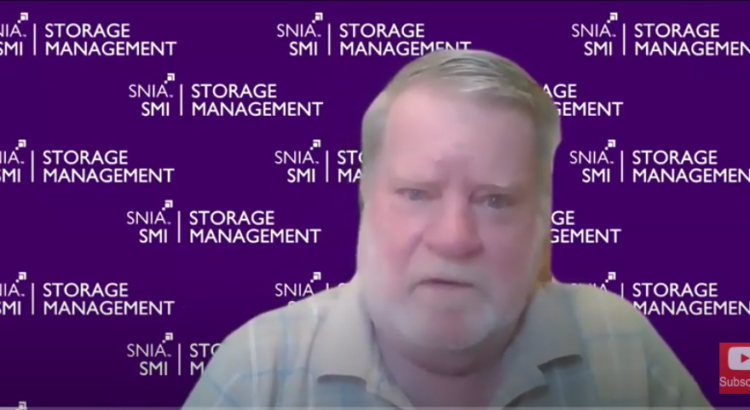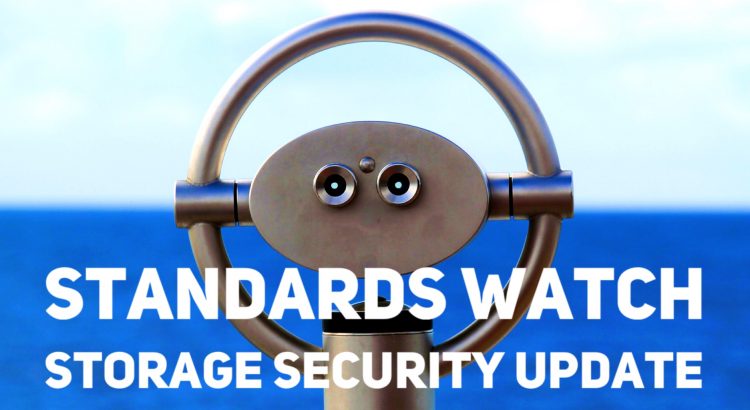
Category: ISO


Standards Watch: Storage Security Update
The world of storage security standards continues to evolve. In fact, it can be hard to keep up with all that’s happening. Here’s a quick recap of SNIA’s involvement and impact on some notable storage security work – past, present and future.
The Storage Security ISO/IEC 27040 standard provides security techniques and detailed technical guidance on how organizations can define an appropriate level of risk mitigation by employing a well-proven and consistent approach to the planning, design, documentation, and implementation of data storage security. SNIA has been a key industry advocate of this standard by providing many of the concepts and best practices dating back to 2006. Recently, the SNIA Storage Security Technical Work Group (TWG) authored a series of white papers that explored a range of topics covered by the ISO/IEC 27040 standard.
Read MoreSNIA LTFS Format – New Version with Improved Capacity Efficiency
 The SNIA Linear Tape File System (LTFS) Technical Work Group (TWG) is excited to announce that the new version of LTFS Format Specification has just been approved. LTFS provides an industry standard format for recording data on modern magnetic tape. LTFS is a file system that allows those stored files to be accessed in a similar fashion to those on disk or removable flash drives.
The SNIA Linear Tape File System (LTFS) Technical Work Group (TWG) is excited to announce that the new version of LTFS Format Specification has just been approved. LTFS provides an industry standard format for recording data on modern magnetic tape. LTFS is a file system that allows those stored files to be accessed in a similar fashion to those on disk or removable flash drives.
The SNIA standard, also known as an ISO standard ISO/IEC 20919:2016, defines the LTFS Format requirements for interchanged media that claims LTFS compliance. Those requirements are specified as the size and sequence of data blocks and file marks on the media, the content and form of special data constructs (the LTFS Label and LTFS Index), and the content of the partition labels and use of MAM parameters.
The data content (not the physical media) of the LTFS format shall be interchangeable among all data storage systems claiming conformance to this format. Physical media interchange is dependent on compatibility of physical media and the media access devices in use.
SNIA on Storage sat down with Takeshi Ishimoto, Co-Chair of the SNIA LTFS Technical Work Group, to learn what it all means.
Q. What is this standard all about? Read More
Take the Leap to SMI-S 1.8 v3 for Streamlined Storage Management

Mike Walker, former chair, SNIA SMI TWG; former IBM engineer
Whether you’re a software provider or a hardware vendor, it’s a good time to check out the latest updates to the Storage Networking Industry Association’s (SNIA’s) Storage Management Initiative Specification (SMI-S) standard. The latest version SMI-S 1.8 v3 is now a SNIA Technical Position that meets your current needs and offers enticing new enhancements for you and your potential new customers. This version will also be sent to the International Organization for Standardization (ISO) for approval, making it a valuable asset worldwide if accepted.
“IT system administrators who demand a choice in storage vendors and infrastructure while ensuring advanced feature enablement through interoperability, have long benefitted from SMI-S,” says Don Deel, chairman, SMI Technical Work Group and SMI Governing Board. “The standard streamlines storage management functions and features into a common set of tools that address the day-to-day tasks of the IT environment.”
Since it was first defined, SMI-S has been continuously updated with new storage management functionality and is now incorporated into over 1,000 storage products. Version 1.5 of the specification received approval by ISO and the International Electrotechnical Commission (IEC) in 2015 and is designated as ISO/IEC 24775.
SMI-S 1.8 v3 represents a significant effort to update the standard. The new version includes a number of editorial changes, clarifications and corrections. It also contains functional enhancements such as new indications, methods, properties and profiles.
Users of SMI-S are being urged to move directly to SMI-S 1.8 v3 since v1.6.1 was the last version that was officially tested. In preparation for submission to ISO, SMI-S 1.8 v3 has been thoroughly reviewed and a number of corrections have been incorporated.
The SMI-S specification is divided into six books which cover the autonomous profiles and component profiles used to manage storage physical and virtual storage area network equipment.
The main new functions since 1.6.1 are in SMI-S 1.8 v3, summarized as follows:
- Fabric Book (Fabric and Switch)
- Peer zoning enhancements
- Enhancements to port speed
- Block Book
- New indications for component health and space management
- Storage Pool Diagnostics
- New method in Block Services
- New methods in Group Masking and Mapping
- Enhancements to Replication Services
- New method in Volume Composition
- Advanced Metrics in Block Server Performance
- Common Profiles Book
- New profile for WBEM Server Management
- New method in iSCSI Target Ports Profile
- Host Book
- New profiles for memory configuration
- Filesystem Book
- New indications for component health and space management
If you would like to hear more details on the recent changes, I recently covered the topic in-depth in a webcast, available as an archived version on the free BrightTALK platform here.
SNIA SMI also offers a comprehensive SMI-S Conformance Testing Program (CTP) to test adherence to the standard. This program offers independent verification of compliance that customers can view directly on the SNIA website at http://www.snia.org/ctp/. Storage buyers can use this information to make sure they are getting software which complies to the latest version of the specification and contains the latest features such as important security functions.
Don’t delay. Update to SMI-S 1.8 v3 today. The specification can be found here. Your one-stop shop for all SMI-S information is: https://www.snia.org/smis.
Get engaged! You can ask and answer questions on the SMI-S Developers Group here
Take the Leap to SMI-S 1.8 v3 for Streamlined Storage Management

Whether you’re a software provider or a hardware vendor, it’s a good time to check out the latest updates to the Storage Networking Industry Association’s (SNIA’s) Storage Management Initiative Specification (SMI-S) standard. The latest version SMI-S 1.8 v3 is now a SNIA Technical Position that meets your current needs and offers enticing new enhancements for you and your potential new customers. This version will also be sent to the International Organization for Standardization (ISO) for approval, making it a valuable asset worldwide if accepted.
“IT system administrators who demand a choice in storage vendors and infrastructure while ensuring advanced feature enablement through interoperability, have long benefitted from SMI-S,” says Don Deel, chairman, SMI Technical Work Group and SMI Governing Board. “The standard streamlines storage management functions and features into a common set of tools that address the day-to-day tasks of the IT environment.”
Since it was first defined, SMI-S has been continuously updated with new storage management functionality and is now incorporated into over 1,000 storage products. Version 1.5 of the specification received approval by ISO and the International Electrotechnical Commission (IEC) in 2015 and is designated as ISO/IEC 24775.
SMI-S 1.8 v3 represents a significant effort to update the standard. The new version includes a number of editorial changes, clarifications and corrections. It also contains functional enhancements such as new indications, methods, properties and profiles.
Users of SMI-S are being urged to move directly to SMI-S 1.8 v3 since v1.6.1 was the last version that was officially tested. In preparation for submission to ISO, SMI-S 1.8 v3 has been thoroughly reviewed and a number of corrections have been incorporated.
The SMI-S specification is divided into six books which cover the autonomous profiles and component profiles used to manage storage physical and virtual storage area network equipment.
The main new functions since 1.6.1 are in SMI-S 1.8 v3, summarized as follows:
- Fabric Book (Fabric and Switch)
- Peer zoning enhancements
- Enhancements to port speed
- Block Book
- New indications for component health and space management
- Storage Pool Diagnostics
- New method in Block Services
- New methods in Group Masking and Mapping
- Enhancements to Replication Services
- New method in Volume Composition
- Advanced Metrics in Block Server Performance
- Common Profiles Book
- New profile for WBEM Server Management
- New method in iSCSI Target Ports Profile
- Host Book
- New profiles for memory configuration
- Filesystem Book
- New indications for component health and space management
If you would like to hear more details on the recent changes, I recently covered the topic in-depth in a webcast, available as an archived version on the free BrightTALK platform here.
SNIA SMI also offers a comprehensive SMI-S Conformance Testing Program (CTP) to test adherence to the standard. This program offers independent verification of compliance that customers can view directly on the SNIA website at http://www.snia.org/ctp/. Storage buyers can use this information to make sure they are getting software which complies to the latest version of the specification and contains the latest features such as important security functions.
Don’t delay. Update to SMI-S 1.8 v3 today. The specification can be found here. Your one-stop shop for all SMI-S information is: https://www.snia.org/smis.
Get engaged! You can ask and answer questions on the SMI-S Developers Group here
Take the Leap to SMI-S 1.8 v3 for Streamlined Storage Management

Whether you’re a software provider or a hardware vendor, it’s a good time to check out the latest updates to the Storage Networking Industry Association’s (SNIA’s) Storage Management Initiative Specification (SMI-S) standard. The latest version SMI-S 1.8 v3 is now a SNIA Technical Position that meets your current needs and offers enticing new enhancements for you and your potential new customers. This version will also be sent to the International Organization for Standardization (ISO) for approval, making it a valuable asset worldwide if accepted.
“IT system administrators who demand a choice in storage vendors and infrastructure while ensuring advanced feature enablement through interoperability, have long benefitted from SMI-S,” says Don Deel, chairman, SMI Technical Work Group and SMI Governing Board. “The standard streamlines storage management functions and features into a common set of tools that address the day-to-day tasks of the IT environment.” Read More
Linear Tape File System Now an International Standard
By David Pease, Co-Chair SNIA Linear Tape File System Technical Working Group
In 2011 the Linear Tape File System (LTFS) earned IBM an Engineering Emmy Award after being recognized by FOX Networks for “improving the ability of media companies to capture, manage and exploit content in digital form, fundamentally changing the way that audio and video content is managed and stored.” Now, the International Standardization Organization (ISO) has named LTFS an International Standard (ISO/IEC 20919:2016).
LTFS’s road to standardization was a long one. It started with IBM and the LTO (Linear Tape Open) Consortium jointly publishing the LTFS Format Specification as an open format in April, 2010, the day that LTFS was announced at the NAB (National Association of Broadcasters) show in Las Vegas. In 2012, at the invitation of the Storage Networking Industry Association (SNIA), we formed the SNIA LTFS Technical Work Group, with a specific goal of moving towards international standardization. The LTFS TWG and SNIA proceeded to publish several revisions of the LTFS Format Specification, inviting all interested parties to join the work group and contribute, or to comment on the specification before formal publication. In 2014 SNIA helped the LTFS TWG format the then-current version of the specification (V2.2) to ISO standards and worked with the ISO organization to publish the specification as a draft standard and solicit comments. After review and comments, the LTFS Format Specification was approved by ISO as an international standard in April of 2016 (just 6 years after it was first announced).
We are thrilled by the recognition of LTFS as an ISO standard; it is one more step towards guaranteeing that the LTFS format is a truly open standard that will continue to be available and usable for the foreseeable future. In my opinion, two of the major inhibitors to the widespread use of tape technology for data storage have been the lack of a standard format for data storage and interchange on tape, and its perceived difficulty of use. LTFS addresses both of these problems by providing a general-purpose, open format that can easily be used like any other storage medium.
As the world’s data continues to grow at an increasing pace, and the need for affordable, large-scale storage becomes more important, the standardization of LTFS will make the use of tape for long-term, affordable storage easier and more attractive.
Use Case: Making Digital Media Storage Open and Future-Proof
Just as in personal photography, the last couple of decades have seen a major shift from analog and film technologies to digital ones in the Media and Entertainment industry, where modern cameras record directly to digital media. This has led to the need for new technologies to replace traditional film as a long-term storage medium for television and movies.
Film has some specific advantages for the Media & Entertainment industry that a new technology needs to replicate, including long shelf life, inexpensive, and zero-power storage, and a format that is “future-proof.” Tape storage is a perfect match to several of these criteria, including long (30+ years) shelf life, and zero-power, inexpensive storage. However, a stumbling block for the wide-spread acceptance of tape for digital storage in the media and entertainment business had been the lack of an open, easy-to-use, future-proof standard for the format of the data on tape. You can imagine an entertainment company using proprietary storage software, for example, only to run into problems like the provider going out of business or increasing its software costs to an unacceptable level.
We created LTFS to be an open and future-proof format from the beginning: open, because when we published the format, we made it publicly available at no charge, and future-proof because the format is self-documenting and can be easily accessed without the need for proprietary software.
Being an international standard should make anyone who is considering the use of LTFS even more comfortable with the fact that it is an open standard that is not owned or controlled by any single company, and is a format that will continue to be supported in the future. As such, becoming an international standard has the potential to increase the use, and therefore the value, of LTFS across industries.
For more information about the work of the SNIA LTFS TWG, please visit www.snia.org/ltfs.